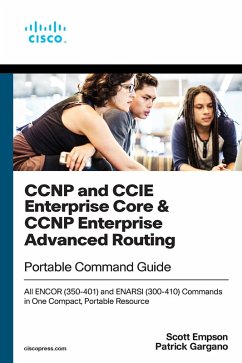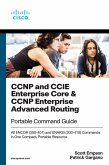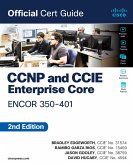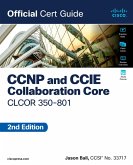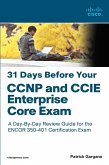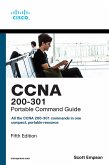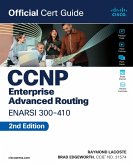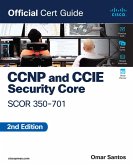CCNP and CCIE Enterprise Core & CCNP Enterprise Advanced Routing Portable Command Guide (eBook, PDF)
All ENCOR (350-401) and ENARSI (300-410) Commands in One Compact, Portable Resource


Alle Infos zum eBook verschenken

CCNP and CCIE Enterprise Core & CCNP Enterprise Advanced Routing Portable Command Guide (eBook, PDF)
All ENCOR (350-401) and ENARSI (300-410) Commands in One Compact, Portable Resource
- Format: PDF
- Merkliste
- Auf die Merkliste
- Bewerten Bewerten
- Teilen
- Produkt teilen
- Produkterinnerung
- Produkterinnerung

Hier können Sie sich einloggen

Bitte loggen Sie sich zunächst in Ihr Kundenkonto ein oder registrieren Sie sich bei bücher.de, um das eBook-Abo tolino select nutzen zu können.
All ENCOR (350-401) and ENARSI (300-410) Commands in One Compact, Portable Resource Use this fully updated quick reference resource to help memorize commands and concepts as you earn your CCNP or CCIE certification. Filled with valuable, easy-to-access information, it's portable enough to use anywhere. This guide summarizes all Cisco IOS software commands, keywords, command arguments, and associated prompts associated with the CCNP and CCIE Enterprise Core (ENCOR 350-401) and CCNP Enterprise Advanced Routing and Services (ENARSI 300-410) certification exams. Tips and examples help you apply…mehr
- Geräte: PC
- ohne Kopierschutz
- eBook Hilfe
- Größe: 5.07MB
![CCNP and CCIE Enterprise Core & CCNP Enterprise Advanced Routing Portable Command Guide (eBook, ePUB) CCNP and CCIE Enterprise Core & CCNP Enterprise Advanced Routing Portable Command Guide (eBook, ePUB)]() Patrick GarganoCCNP and CCIE Enterprise Core & CCNP Enterprise Advanced Routing Portable Command Guide (eBook, ePUB)21,95 €
Patrick GarganoCCNP and CCIE Enterprise Core & CCNP Enterprise Advanced Routing Portable Command Guide (eBook, ePUB)21,95 €![CCNP and CCIE Enterprise Core ENCOR 350-401 Official Cert Guide (eBook, PDF) CCNP and CCIE Enterprise Core ENCOR 350-401 Official Cert Guide (eBook, PDF)]() Brad EdgeworthCCNP and CCIE Enterprise Core ENCOR 350-401 Official Cert Guide (eBook, PDF)37,95 €
Brad EdgeworthCCNP and CCIE Enterprise Core ENCOR 350-401 Official Cert Guide (eBook, PDF)37,95 €![CCNP and CCIE Collaboration Core CLCOR 350-801 Official Cert Guide (eBook, PDF) CCNP and CCIE Collaboration Core CLCOR 350-801 Official Cert Guide (eBook, PDF)]() Jason BallCCNP and CCIE Collaboration Core CLCOR 350-801 Official Cert Guide (eBook, PDF)42,95 €
Jason BallCCNP and CCIE Collaboration Core CLCOR 350-801 Official Cert Guide (eBook, PDF)42,95 €![31 Days Before Your CCNP and CCIE Enterprise Core Exam (eBook, PDF) 31 Days Before Your CCNP and CCIE Enterprise Core Exam (eBook, PDF)]() Patrick Gargano31 Days Before Your CCNP and CCIE Enterprise Core Exam (eBook, PDF)25,95 €
Patrick Gargano31 Days Before Your CCNP and CCIE Enterprise Core Exam (eBook, PDF)25,95 €![CCNA 200-301 Portable Command Guide (eBook, PDF) CCNA 200-301 Portable Command Guide (eBook, PDF)]() Scott EmpsonCCNA 200-301 Portable Command Guide (eBook, PDF)19,95 €
Scott EmpsonCCNA 200-301 Portable Command Guide (eBook, PDF)19,95 €![CCNP Enterprise Advanced Routing ENARSI 300-410 Official Cert Guide (eBook, PDF) CCNP Enterprise Advanced Routing ENARSI 300-410 Official Cert Guide (eBook, PDF)]() Brad EdgeworthCCNP Enterprise Advanced Routing ENARSI 300-410 Official Cert Guide (eBook, PDF)39,95 €
Brad EdgeworthCCNP Enterprise Advanced Routing ENARSI 300-410 Official Cert Guide (eBook, PDF)39,95 €![CCNP and CCIE Security Core SCOR 350-701 Official Cert Guide (eBook, PDF) CCNP and CCIE Security Core SCOR 350-701 Official Cert Guide (eBook, PDF)]() Omar SantosCCNP and CCIE Security Core SCOR 350-701 Official Cert Guide (eBook, PDF)37,95 €
Omar SantosCCNP and CCIE Security Core SCOR 350-701 Official Cert Guide (eBook, PDF)37,95 €-
-
-
- Layer 2: VLANs, STP, Inter-VLAN Routing
- Layer 3: EIGRP, OSPF, Redistribution, Path Control, BGP
- Infrastructure Services and Management
- Infrastructure Security
- Network Assurance
- Wireless Security and Troubleshooting
- Overlays and Virtualization
- Logical how-to topic groupings for a one-stop resource
- Great for review before your ENCOR 350-401 and ENARSI 300-410 certification exams
- Compact size makes it easy to carry with you wherever you go
- "Create Your Own Journal" section with blank, lined pages enables you to personalize the book for your needs
Dieser Download kann aus rechtlichen Gründen nur mit Rechnungsadresse in A, B, BG, CY, CZ, D, DK, EW, E, FIN, F, GR, HR, H, IRL, I, LT, L, LR, M, NL, PL, P, R, S, SLO, SK ausgeliefert werden.
- Produktdetails
- Verlag: Pearson ITP
- Seitenzahl: 416
- Altersempfehlung: ab 18 Jahre
- Erscheinungstermin: 26. März 2020
- Englisch
- ISBN-13: 9780135768327
- Artikelnr.: 61770601
- Verlag: Pearson ITP
- Seitenzahl: 416
- Altersempfehlung: ab 18 Jahre
- Erscheinungstermin: 26. März 2020
- Englisch
- ISBN-13: 9780135768327
- Artikelnr.: 61770601
- Herstellerkennzeichnung Die Herstellerinformationen sind derzeit nicht verfügbar.
PART I: LAYER 2 INFRASTRUCTURE
Chapter 1 VLANs 1
Virtual LANs 1
Creating Static VLANs Using VLAN Configuration Mode 2
Assigning Ports to Data and Voice VLANs 2
Using the range Command 3
Dynamic Trunking Protocol (DTP) 3
Setting the Trunk Encapsulation and Allowed VLANs 4
VLAN Trunking Protocol (VTP) 5
Verifying VTP 6
Verifying VLAN Information 7
Saving VLAN Configurations 7
Erasing VLAN Configurations 7
Configuration Example: VLANs 8
Layer 2 Link Aggregation 11
Interface Modes in EtherChannel 12
Default EtherChannel Configuration 12
Guidelines for Configuring EtherChannel 12
Configuring Layer 2 EtherChannel 14
Configuring Layer 3 EtherChannel 14
Configuring EtherChannel Load Balancing 15
Configuring LACP Hot-Standby Ports 16
Monitoring and Verifying EtherChannel 17
Configuration Example: EtherChannel 18
Chapter 2 Spanning Tree Protocol 23
Spanning Tree Protocol Definition 24
Enabling Spanning Tree Protocol 24
Changing the Spanning-Tree Mode 25
Configuring the Root Switch 25
Configuring a Secondary Root Switch 26
Configuring Port Priority 26
Configuring the Path Cost 27
Configuring the Switch Priority of a VLAN 27
Configuring STP Timers 27
Configuring Optional Spanning-Tree Features 28
PortFast 28
BPDU Guard (2xxx/older 3xxx Series) 29
BPDU Guard (3650/9xxx Series) 29
BPDU Filter 30
UplinkFast 30
BackboneFast 31
Root Guard 31
Loop Guard 32
Unidirectional Link Detection 33
Configuring and Verifying Port Error Conditions 33
Enabling Rapid Spanning Tree 36
Rapid Spanning Tree Link Types 36
Enabling Multiple Spanning Tree 37
Verifying the Extended System ID 39
Verifying STP 39
Troubleshooting Spanning Tree Protocol 40
Configuration Example: PVST+ 40
Spanning-Tree Migration Example: PVST+ to Rapid-PVST+ 43
Chapter 3 Implementing Inter-VLAN Routing 45
Inter-VLAN Communication Using an External Router: Router-on-a-Stick 45
Inter-VLAN Communication Tips 46
Inter-VLAN Communication on a Multilayer Switch Through a Switch Virtual
Interface 46
Configuring Inter-VLAN Communication on an L3 Switch 47
Removing L2 Switchport Capability of an Interface on an L3 Switch
47
Configuration Example: Inter-VLAN Communication 47
Configuration Example: IPv6 Inter-VLAN Communication 55
PART II: LAYER 3 INFRASTRUCTURE
Chapter 4 EIGRP 61
Enhanced Interior Gateway Routing Protocol (EIGRP) 62
Enabling EIGRP for IPv4 Using Classic Mode Configuration 62
Enabling EIGRP for IPv6 Using Classic Mode Configuration 63
EIGRP Using Named Mode Configuration 64
EIGRP Named Mode Subconfiguration Modes 66
Upgrading Classic Mode to Named Mode Configuration 66
EIGRP Router ID 67
Authentication for EIGRP 67
Configuring Authentication in Classic Mode 67
Configuring Authentication in Named Mode 68
Verifying and Troubleshooting EIGRP Authentication 70
Auto-Summarization for EIGRP 70
IPv4 Manual Summarization for EIGRP 70
IPv6 Manual Summarization for EIGRP 71
Timers for EIGRP 71
Passive Interfaces for EIGRP 72
Pseudo Passive EIGRP Interfaces 72
Injecting a Default Route into EIGRP: Redistribution of a Static Route
73
Injecting a Default Route into EIGRP: ip default-network 74
Injecting a Default Route into EIGRP: Summarize to 0.0.0.0/0 74
Accepting Exterior Routing Information: default-information 75
Equal-cost Load Balancing: maximum-paths 75
Unequal-cost Load Balancing: variance 76
EIGRP Traffic Sharing 76
Bandwidth Use for EIGRP 77
Stub Routing for EIGRP 77
EIGRP Unicast Neighbors 79
EIGRP Wide Metrics 79
Adjusting the EIGRP Metric Weights 80
Verifying EIGRP 80
Troubleshooting EIGRP 82
Configuration Example: EIGRP for IPv4 and IPv6 Using Named Mode 83
Chapter 5 OSPF 87
Comparing OSPFv2 and OSPFv3 88
Configuring OSPF 89
Configuring Multiarea OSPF 89
Using Wildcard Masks with OSPF Areas 90
Configuring Traditional OSPFv3 91
Enabling OSPF for IPv6 on an Interface 91
OSPFv3 and Stub/NSSA Areas 92
Interarea OSPFv3 Route Summarization 92
Enabling an IPv4 Router ID for OSPFv3 93
Forcing an SPF Calculation 93
OSPFv3 Address Families 93
Configuring the IPv6 Address Family in OSPFv3 94
Configuring the IPv4 Address Family in OSPFv3 94
Applying Parameters in Address Family Configuration Mode 94
Authentication for OSPF 95
Configuring OSPFv2 Authentication: Simple Password 95
Configuring OSPFv2 Cryptographic Authentication: SHA-256 96
Configuring OSPFv3 Authentication and Encryption 97
Verifying OSPFv2 and OSPFv3 Authentication 98
Optimizing OSPF Parameters 98
Loopback Interfaces 98
Router ID 99
DR/BDR Elections 99
Passive Interfaces 100
Modifying Cost Metrics 100
OSPF Reference Bandwidth 101
OSPF LSDB Overload Protection 101
Timers 101
IP MTU 102
Propagating a Default Route 102
Route Summarization 103
Interarea Route Summarization 103
External Route Summarization 103
OSPF Route Filtering 104
Using the filter-list Command 104
Using the area range not-advertise Command 104
Using the distribute-list in Command 104
Using the summary-address not-advertise Command 105
OSPF Special Area Types 105
Stub Areas 105
Totally Stubby Areas 106
Not-So-Stubby Areas (NSSA) 106
Totally NSSA 107
Virtual Links 108
Configuration Example: Virtual Links 108
Verifying OSPF Configuration 109
Troubleshooting OSPF 111
Configuration Example: Single-Area OSPF 111
Configuration Example: Multiarea OSPF 114
Configuration Example: Traditional OSPFv3 117
Configuration Example: OSPFv3 with Address Families 120
Chapter 6 Redistribution and Path Control 127
Defining Seed and Default Metrics 128
Redistributing Connected Networks 129
Redistributing Static Routes 129
Redistributing Subnets into OSPF 130
Assigning E1 or E2 Routes in OSPF 130
Redistributing OSPF Internal and External Routes 131
Configuration Example: Route Redistribution for IPv4 131
Configuration Example: Route Redistribution for IPv6 132
Verifying Route Redistribution 134
Route Filtering Using the distribute-list Command 134
Configuration Example: Inbound and Outbound Distribute List Route
Filters 134
Configuration Example: Controlling Redistribution with Outbound
Distribute Lists 135
Verifying Route Filters 136
Route Filtering Using Prefix Lists 137
Configuration Example: Using a Distribute List That References a Prefix
List to Control Redistribution 139
Verifying Prefix Lists 140
Using Route Maps with Route Redistribution 140
Configuration Example: Route Maps 141
Manipulating Redistribution Using Route Tagging 142
Changing Administrative Distance 143
Path Control with Policy-Based Routing 144
Verifying Policy-Based Routing 145
Configuration Example: PBR with Route Maps 146
Cisco IOS IP SLA 147
Configuring Authentication for IP SLA 149
Monitoring IP SLA Operations 150
PBR with Cisco IOS IP SLA 150
Step 1: Define Probe(s) 151
Step 2: Define Tracking Object(s) 152
Step 3a: Define the Action on the Tracking Object(s) 152
Step 3b: Define Policy Routing Using the Tracking Object(s) 152
Step 4: Verify IP SLA Operations 152
Chapter 7 BGP 155
Configuring BGP: Classic Configuration 156
Configuring Multiprotocol BGP (MP-BGP) 157
Configuring BGP: Address Families 158
Configuration Example: Using MP-BGP Address Families to Exchange IPv4 and
IPv6 Routes 159
BGP Support for 4-Byte AS Numbers 160
BGP Timers 161
BGP and update-source 161
IBGP Next-Hop Behavior 162
EBGP Multihop 162
Attributes 164
Route Selection Decision ProcessThe BGP Best Path Algorithm 164
Weight Attribute 164
Using AS Path Access Lists to Manipulate the Weight Attribute 166
Using Prefix Lists and Route Maps to Manipulate the Weight
Attribute 166
Local Preference Attribute 167
Using AS Path Access Lists with Route Maps to Manipulate the Local
Preference Attribute 167
AS Path Attribute Prepending 169
AS Path: Removing Private Autonomous Systems 171
Multi-Exit Discriminator (MED) Attribute 171
Verifying BGP 174
Troubleshooting BGP 175
Default Routes 177
Route Aggregation 177
Route Reflectors 177
Regular Expressions 178
Regular Expressions: Examples 179
BGP Route Filtering Using Access Lists and Distribute Lists 180
Configuration Example: Using Prefix Lists and AS Path Access Lists 181
BGP Peer Groups 182
Authentication for BGP 184
Configuring Authentication Between BGP Peers 184
Verifying BGP Authentication 184
PART III: INFRASTRUCTURE SERVICES
Chapter 8 IP Services 185
Network Address Translation (NAT) 186
Private IP Addresses: RFC 1918 186
Configuring Static NAT 187
Configuring Dynamic NAT 188
Configuring Port Address Translation (PAT) 189
Configuring a NAT Virtual Interface 190
Verifying NAT and PAT Configurations 190
Troubleshooting NAT and PAT Configurations 191
Configuration Example: PAT 191
Configuration Example: NAT Virtual Interfaces and Static NAT 193
First-Hop Redundancy Protocols 194
Hot Standby Router Protocol 194
Virtual Router Redundancy Protocol 201
IPv4 Configuration Example: HSRP on L3 Switch 204
IPv4 Configuration Example: VRRPv2 on Router and L3 Switch with IP SLA
Tracking 209
IPv6 Configuration Example: HSRPv2 on Router and L3 Switch 212
Dynamic Host Control Protocol (DHCP) 217
Implementing DHCP for IPv4 217
Implementing DHCP for IPv6 221
Configuration Example: DHCP for IPv4 224
Configuration Example: DHCP for IPv6 226
Chapter 9 Device Management 231
Configuring Passwords 231
Cleartext Password Encryption 232
Password Encryption Algorithm Types 233
Configuring SSH 234
Verifying SSH 235
Boot System Commands 235
The Cisco IOS File System 236
Viewing the Cisco IOS File System 236
Commonly Used URL Prefixes for Cisco Network Devices 236
Deciphering IOS Image Filenames 237
Backing Up Configurations to a TFTP Server 238
Restoring Configurations from a TFTP Server 238
Backing Up the Cisco IOS Software to a TFTP Server 239
Restoring/Upgrading the Cisco IOS Software from a TFTP Server 239
Restoring the Cisco IOS Software Using the ROM Monitor Environmental
Variables and tftpdnld Command 240
Secure Copy Protocol (SCP) 241
Configuring an SCP Server 241
Verifying and Troubleshooting SCP 241
Configuration Example: SCP 241
Disabling Unneeded Services 242
Useful Device Management Options 243
PART IV: INFRASTRUCTURE SECURITY
Chapter 10 Infrastructure Security 245
IPv4 Access Control Lists (ACLs) 246
Configuring and Applying Standard IPv4 ACLs 246
Configuring and Applying Extended IPv4 ACLs 247
Configuring and Applying Time-based ACLs 248
Configuring and Applying VTY ACLs 249
IPv6 ACLs 250
Configuring and Applying IPv6 ACLs 250
Verifying IPv4 and IPv6 ACLs 251
Implementing Authentication Methods 251
Simple Local Database Authentication 252
AAA-based Local Database Authentication 252
RADIUS Authentication 253
TACACS+ Authentication 255
Configuring Authorization and Accounting 256
Troubleshooting AAA 257
Control Plane Policing (CoPP) 257
Step 1: Define ACLs to Identify Permitted CoPP Traffic Flows 258
Step 2: Define Class Maps for Matched Traffic 258
Step 3: Define a Policy Map to Police Matched Traffic 259
Step 4: Assign a Policy Map to the Control Plane 259
Verifying CoPP 260
Unicast Reverse Path Forwarding (uRPF) 260
Configuring uRPF 260
Verifying and Troubleshooting uRPF 260
PART V: NETWORK ASSURANCE
Chapter 11 Network Assurance 261
Internet Control Message Protocol Redirect Messages 262
The ping Command 262
Examples of Using the ping and the Extended ping Commands 263
The traceroute Command 265
The debug Command 265
Conditionally Triggered Debugs 266
Configuring Secure SNMP 267
Securing SNMPv1 or SNMPv2c 267
Securing SNMPv3 268
Verifying SNMP 269
Implementing Logging 269
Configuring Syslog 269
Syslog Message Format 269
Syslog Severity Levels 270
Syslog Message Example 270
Configuring NetFlow 271
Configuring Flexible NetFlow 272
Step 1: Configure a Flow Record 272
Step 2: Configure a Flow Exporter 272
Step 3: Configure a Flow Monitor 272
Step 4: Apply the Flow Monitor to an Interface 273
Verifying NetFlow 273
Implementing Port Mirroring 273
Default SPAN and RSPAN Configuration 273
Configuring Local SPAN 274
Local SPAN Guidelines for Configuration 274
Configuration Example: Local SPAN 274
Configuring Remote SPAN 277
Remote SPAN Guidelines for Configuration 278
Configuration Example: Remote SPAN 278
Configuring Encapsulated RSPAN (ERSPAN) 280
Verifying and Troubleshooting Local and Remote SPAN 281
Configuring Network Time Protocol 281
NTP Configuration 281
NTP Design 282
Securing NTP 284
Verifying and Troubleshooting NTP 286
Setting the Clock on a Router 286
Using Time Stamps 290
Configuration Example: NTP 290
Tool Command Language (Tcl) 294
Embedded Event Manager (EEM) 295
EEM Configuration Examples 296
EEM and Tcl Scripts 298
Verifying EEM 298
PART VI: WIRELESS
Chapter 12 Wireless Security and Troubleshooting 299
Authenticating Wireless Clients 299
Open Authentication 300
Authenticating with a Pre-shared Key 302
Authenticating with EAP 304
Authenticating with WebAuth 310
Troubleshooting from the Wireless LAN Controller 312
Troubleshooting Wireless Client Connectivity 318
Cisco AireOS Monitoring Dashboard GUI 318
Cisco IOS XE GUI 322
PART VII: OVERLAYS AND VIRTUALIZATION
Chapter 13 Overlay Tunnels and VRF 325
Generic Routing Encapsulation (GRE) 325
Configuring an IPv4 GRE Tunnel 326
Configuring an IPv6 GRE Tunnel 326
Verifying IPv4 and IPv6 GRE Tunnels 327
Configuration Example: IPv4 and IPv6 GRE Tunnels with OSPFv3 327
Site-to-Site GRE over IPsec 331
GRE/IPsec Using Crypto Maps 332
GRE/IPsec Using IPsec Profiles 333
Verifying GRE/IPsec 335
Site-to-Site Virtual Tunnel Interface (VTI) over IPsec 335
Cisco Dynamic Multipoint VPN (DMVPN) 336
Configuration Example: Cisco DMVPN for IPv4 337
Verifying Cisco DMVPN 342
VRF-Lite 343
Configuring VRF-Lite 343
Verifying VRF-Lite 345
Appendix A: Create Your Own Journal Here 347
Index 361
PART I: LAYER 2 INFRASTRUCTURE
Chapter 1 VLANs 1
Virtual LANs 1
Creating Static VLANs Using VLAN Configuration Mode 2
Assigning Ports to Data and Voice VLANs 2
Using the range Command 3
Dynamic Trunking Protocol (DTP) 3
Setting the Trunk Encapsulation and Allowed VLANs 4
VLAN Trunking Protocol (VTP) 5
Verifying VTP 6
Verifying VLAN Information 7
Saving VLAN Configurations 7
Erasing VLAN Configurations 7
Configuration Example: VLANs 8
Layer 2 Link Aggregation 11
Interface Modes in EtherChannel 12
Default EtherChannel Configuration 12
Guidelines for Configuring EtherChannel 12
Configuring Layer 2 EtherChannel 14
Configuring Layer 3 EtherChannel 14
Configuring EtherChannel Load Balancing 15
Configuring LACP Hot-Standby Ports 16
Monitoring and Verifying EtherChannel 17
Configuration Example: EtherChannel 18
Chapter 2 Spanning Tree Protocol 23
Spanning Tree Protocol Definition 24
Enabling Spanning Tree Protocol 24
Changing the Spanning-Tree Mode 25
Configuring the Root Switch 25
Configuring a Secondary Root Switch 26
Configuring Port Priority 26
Configuring the Path Cost 27
Configuring the Switch Priority of a VLAN 27
Configuring STP Timers 27
Configuring Optional Spanning-Tree Features 28
PortFast 28
BPDU Guard (2xxx/older 3xxx Series) 29
BPDU Guard (3650/9xxx Series) 29
BPDU Filter 30
UplinkFast 30
BackboneFast 31
Root Guard 31
Loop Guard 32
Unidirectional Link Detection 33
Configuring and Verifying Port Error Conditions 33
Enabling Rapid Spanning Tree 36
Rapid Spanning Tree Link Types 36
Enabling Multiple Spanning Tree 37
Verifying the Extended System ID 39
Verifying STP 39
Troubleshooting Spanning Tree Protocol 40
Configuration Example: PVST+ 40
Spanning-Tree Migration Example: PVST+ to Rapid-PVST+ 43
Chapter 3 Implementing Inter-VLAN Routing 45
Inter-VLAN Communication Using an External Router: Router-on-a-Stick 45
Inter-VLAN Communication Tips 46
Inter-VLAN Communication on a Multilayer Switch Through a Switch Virtual
Interface 46
Configuring Inter-VLAN Communication on an L3 Switch 47
Removing L2 Switchport Capability of an Interface on an L3 Switch
47
Configuration Example: Inter-VLAN Communication 47
Configuration Example: IPv6 Inter-VLAN Communication 55
PART II: LAYER 3 INFRASTRUCTURE
Chapter 4 EIGRP 61
Enhanced Interior Gateway Routing Protocol (EIGRP) 62
Enabling EIGRP for IPv4 Using Classic Mode Configuration 62
Enabling EIGRP for IPv6 Using Classic Mode Configuration 63
EIGRP Using Named Mode Configuration 64
EIGRP Named Mode Subconfiguration Modes 66
Upgrading Classic Mode to Named Mode Configuration 66
EIGRP Router ID 67
Authentication for EIGRP 67
Configuring Authentication in Classic Mode 67
Configuring Authentication in Named Mode 68
Verifying and Troubleshooting EIGRP Authentication 70
Auto-Summarization for EIGRP 70
IPv4 Manual Summarization for EIGRP 70
IPv6 Manual Summarization for EIGRP 71
Timers for EIGRP 71
Passive Interfaces for EIGRP 72
Pseudo Passive EIGRP Interfaces 72
Injecting a Default Route into EIGRP: Redistribution of a Static Route
73
Injecting a Default Route into EIGRP: ip default-network 74
Injecting a Default Route into EIGRP: Summarize to 0.0.0.0/0 74
Accepting Exterior Routing Information: default-information 75
Equal-cost Load Balancing: maximum-paths 75
Unequal-cost Load Balancing: variance 76
EIGRP Traffic Sharing 76
Bandwidth Use for EIGRP 77
Stub Routing for EIGRP 77
EIGRP Unicast Neighbors 79
EIGRP Wide Metrics 79
Adjusting the EIGRP Metric Weights 80
Verifying EIGRP 80
Troubleshooting EIGRP 82
Configuration Example: EIGRP for IPv4 and IPv6 Using Named Mode 83
Chapter 5 OSPF 87
Comparing OSPFv2 and OSPFv3 88
Configuring OSPF 89
Configuring Multiarea OSPF 89
Using Wildcard Masks with OSPF Areas 90
Configuring Traditional OSPFv3 91
Enabling OSPF for IPv6 on an Interface 91
OSPFv3 and Stub/NSSA Areas 92
Interarea OSPFv3 Route Summarization 92
Enabling an IPv4 Router ID for OSPFv3 93
Forcing an SPF Calculation 93
OSPFv3 Address Families 93
Configuring the IPv6 Address Family in OSPFv3 94
Configuring the IPv4 Address Family in OSPFv3 94
Applying Parameters in Address Family Configuration Mode 94
Authentication for OSPF 95
Configuring OSPFv2 Authentication: Simple Password 95
Configuring OSPFv2 Cryptographic Authentication: SHA-256 96
Configuring OSPFv3 Authentication and Encryption 97
Verifying OSPFv2 and OSPFv3 Authentication 98
Optimizing OSPF Parameters 98
Loopback Interfaces 98
Router ID 99
DR/BDR Elections 99
Passive Interfaces 100
Modifying Cost Metrics 100
OSPF Reference Bandwidth 101
OSPF LSDB Overload Protection 101
Timers 101
IP MTU 102
Propagating a Default Route 102
Route Summarization 103
Interarea Route Summarization 103
External Route Summarization 103
OSPF Route Filtering 104
Using the filter-list Command 104
Using the area range not-advertise Command 104
Using the distribute-list in Command 104
Using the summary-address not-advertise Command 105
OSPF Special Area Types 105
Stub Areas 105
Totally Stubby Areas 106
Not-So-Stubby Areas (NSSA) 106
Totally NSSA 107
Virtual Links 108
Configuration Example: Virtual Links 108
Verifying OSPF Configuration 109
Troubleshooting OSPF 111
Configuration Example: Single-Area OSPF 111
Configuration Example: Multiarea OSPF 114
Configuration Example: Traditional OSPFv3 117
Configuration Example: OSPFv3 with Address Families 120
Chapter 6 Redistribution and Path Control 127
Defining Seed and Default Metrics 128
Redistributing Connected Networks 129
Redistributing Static Routes 129
Redistributing Subnets into OSPF 130
Assigning E1 or E2 Routes in OSPF 130
Redistributing OSPF Internal and External Routes 131
Configuration Example: Route Redistribution for IPv4 131
Configuration Example: Route Redistribution for IPv6 132
Verifying Route Redistribution 134
Route Filtering Using the distribute-list Command 134
Configuration Example: Inbound and Outbound Distribute List Route
Filters 134
Configuration Example: Controlling Redistribution with Outbound
Distribute Lists 135
Verifying Route Filters 136
Route Filtering Using Prefix Lists 137
Configuration Example: Using a Distribute List That References a Prefix
List to Control Redistribution 139
Verifying Prefix Lists 140
Using Route Maps with Route Redistribution 140
Configuration Example: Route Maps 141
Manipulating Redistribution Using Route Tagging 142
Changing Administrative Distance 143
Path Control with Policy-Based Routing 144
Verifying Policy-Based Routing 145
Configuration Example: PBR with Route Maps 146
Cisco IOS IP SLA 147
Configuring Authentication for IP SLA 149
Monitoring IP SLA Operations 150
PBR with Cisco IOS IP SLA 150
Step 1: Define Probe(s) 151
Step 2: Define Tracking Object(s) 152
Step 3a: Define the Action on the Tracking Object(s) 152
Step 3b: Define Policy Routing Using the Tracking Object(s) 152
Step 4: Verify IP SLA Operations 152
Chapter 7 BGP 155
Configuring BGP: Classic Configuration 156
Configuring Multiprotocol BGP (MP-BGP) 157
Configuring BGP: Address Families 158
Configuration Example: Using MP-BGP Address Families to Exchange IPv4 and
IPv6 Routes 159
BGP Support for 4-Byte AS Numbers 160
BGP Timers 161
BGP and update-source 161
IBGP Next-Hop Behavior 162
EBGP Multihop 162
Attributes 164
Route Selection Decision ProcessThe BGP Best Path Algorithm 164
Weight Attribute 164
Using AS Path Access Lists to Manipulate the Weight Attribute 166
Using Prefix Lists and Route Maps to Manipulate the Weight
Attribute 166
Local Preference Attribute 167
Using AS Path Access Lists with Route Maps to Manipulate the Local
Preference Attribute 167
AS Path Attribute Prepending 169
AS Path: Removing Private Autonomous Systems 171
Multi-Exit Discriminator (MED) Attribute 171
Verifying BGP 174
Troubleshooting BGP 175
Default Routes 177
Route Aggregation 177
Route Reflectors 177
Regular Expressions 178
Regular Expressions: Examples 179
BGP Route Filtering Using Access Lists and Distribute Lists 180
Configuration Example: Using Prefix Lists and AS Path Access Lists 181
BGP Peer Groups 182
Authentication for BGP 184
Configuring Authentication Between BGP Peers 184
Verifying BGP Authentication 184
PART III: INFRASTRUCTURE SERVICES
Chapter 8 IP Services 185
Network Address Translation (NAT) 186
Private IP Addresses: RFC 1918 186
Configuring Static NAT 187
Configuring Dynamic NAT 188
Configuring Port Address Translation (PAT) 189
Configuring a NAT Virtual Interface 190
Verifying NAT and PAT Configurations 190
Troubleshooting NAT and PAT Configurations 191
Configuration Example: PAT 191
Configuration Example: NAT Virtual Interfaces and Static NAT 193
First-Hop Redundancy Protocols 194
Hot Standby Router Protocol 194
Virtual Router Redundancy Protocol 201
IPv4 Configuration Example: HSRP on L3 Switch 204
IPv4 Configuration Example: VRRPv2 on Router and L3 Switch with IP SLA
Tracking 209
IPv6 Configuration Example: HSRPv2 on Router and L3 Switch 212
Dynamic Host Control Protocol (DHCP) 217
Implementing DHCP for IPv4 217
Implementing DHCP for IPv6 221
Configuration Example: DHCP for IPv4 224
Configuration Example: DHCP for IPv6 226
Chapter 9 Device Management 231
Configuring Passwords 231
Cleartext Password Encryption 232
Password Encryption Algorithm Types 233
Configuring SSH 234
Verifying SSH 235
Boot System Commands 235
The Cisco IOS File System 236
Viewing the Cisco IOS File System 236
Commonly Used URL Prefixes for Cisco Network Devices 236
Deciphering IOS Image Filenames 237
Backing Up Configurations to a TFTP Server 238
Restoring Configurations from a TFTP Server 238
Backing Up the Cisco IOS Software to a TFTP Server 239
Restoring/Upgrading the Cisco IOS Software from a TFTP Server 239
Restoring the Cisco IOS Software Using the ROM Monitor Environmental
Variables and tftpdnld Command 240
Secure Copy Protocol (SCP) 241
Configuring an SCP Server 241
Verifying and Troubleshooting SCP 241
Configuration Example: SCP 241
Disabling Unneeded Services 242
Useful Device Management Options 243
PART IV: INFRASTRUCTURE SECURITY
Chapter 10 Infrastructure Security 245
IPv4 Access Control Lists (ACLs) 246
Configuring and Applying Standard IPv4 ACLs 246
Configuring and Applying Extended IPv4 ACLs 247
Configuring and Applying Time-based ACLs 248
Configuring and Applying VTY ACLs 249
IPv6 ACLs 250
Configuring and Applying IPv6 ACLs 250
Verifying IPv4 and IPv6 ACLs 251
Implementing Authentication Methods 251
Simple Local Database Authentication 252
AAA-based Local Database Authentication 252
RADIUS Authentication 253
TACACS+ Authentication 255
Configuring Authorization and Accounting 256
Troubleshooting AAA 257
Control Plane Policing (CoPP) 257
Step 1: Define ACLs to Identify Permitted CoPP Traffic Flows 258
Step 2: Define Class Maps for Matched Traffic 258
Step 3: Define a Policy Map to Police Matched Traffic 259
Step 4: Assign a Policy Map to the Control Plane 259
Verifying CoPP 260
Unicast Reverse Path Forwarding (uRPF) 260
Configuring uRPF 260
Verifying and Troubleshooting uRPF 260
PART V: NETWORK ASSURANCE
Chapter 11 Network Assurance 261
Internet Control Message Protocol Redirect Messages 262
The ping Command 262
Examples of Using the ping and the Extended ping Commands 263
The traceroute Command 265
The debug Command 265
Conditionally Triggered Debugs 266
Configuring Secure SNMP 267
Securing SNMPv1 or SNMPv2c 267
Securing SNMPv3 268
Verifying SNMP 269
Implementing Logging 269
Configuring Syslog 269
Syslog Message Format 269
Syslog Severity Levels 270
Syslog Message Example 270
Configuring NetFlow 271
Configuring Flexible NetFlow 272
Step 1: Configure a Flow Record 272
Step 2: Configure a Flow Exporter 272
Step 3: Configure a Flow Monitor 272
Step 4: Apply the Flow Monitor to an Interface 273
Verifying NetFlow 273
Implementing Port Mirroring 273
Default SPAN and RSPAN Configuration 273
Configuring Local SPAN 274
Local SPAN Guidelines for Configuration 274
Configuration Example: Local SPAN 274
Configuring Remote SPAN 277
Remote SPAN Guidelines for Configuration 278
Configuration Example: Remote SPAN 278
Configuring Encapsulated RSPAN (ERSPAN) 280
Verifying and Troubleshooting Local and Remote SPAN 281
Configuring Network Time Protocol 281
NTP Configuration 281
NTP Design 282
Securing NTP 284
Verifying and Troubleshooting NTP 286
Setting the Clock on a Router 286
Using Time Stamps 290
Configuration Example: NTP 290
Tool Command Language (Tcl) 294
Embedded Event Manager (EEM) 295
EEM Configuration Examples 296
EEM and Tcl Scripts 298
Verifying EEM 298
PART VI: WIRELESS
Chapter 12 Wireless Security and Troubleshooting 299
Authenticating Wireless Clients 299
Open Authentication 300
Authenticating with a Pre-shared Key 302
Authenticating with EAP 304
Authenticating with WebAuth 310
Troubleshooting from the Wireless LAN Controller 312
Troubleshooting Wireless Client Connectivity 318
Cisco AireOS Monitoring Dashboard GUI 318
Cisco IOS XE GUI 322
PART VII: OVERLAYS AND VIRTUALIZATION
Chapter 13 Overlay Tunnels and VRF 325
Generic Routing Encapsulation (GRE) 325
Configuring an IPv4 GRE Tunnel 326
Configuring an IPv6 GRE Tunnel 326
Verifying IPv4 and IPv6 GRE Tunnels 327
Configuration Example: IPv4 and IPv6 GRE Tunnels with OSPFv3 327
Site-to-Site GRE over IPsec 331
GRE/IPsec Using Crypto Maps 332
GRE/IPsec Using IPsec Profiles 333
Verifying GRE/IPsec 335
Site-to-Site Virtual Tunnel Interface (VTI) over IPsec 335
Cisco Dynamic Multipoint VPN (DMVPN) 336
Configuration Example: Cisco DMVPN for IPv4 337
Verifying Cisco DMVPN 342
VRF-Lite 343
Configuring VRF-Lite 343
Verifying VRF-Lite 345
Appendix A: Create Your Own Journal Here 347
Index 361
